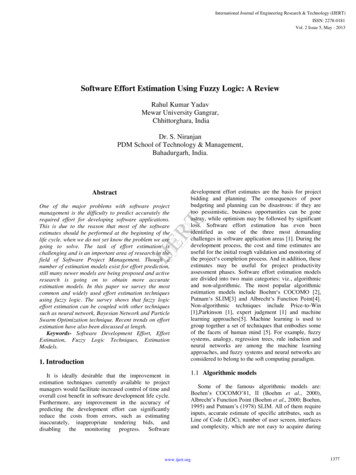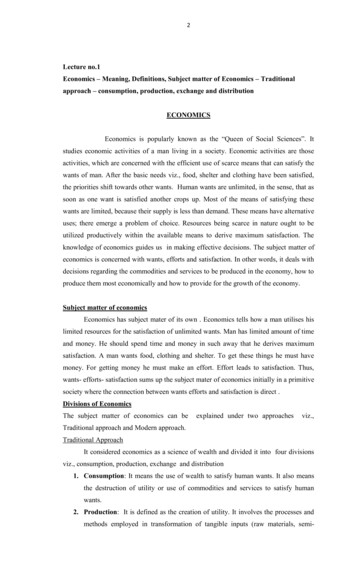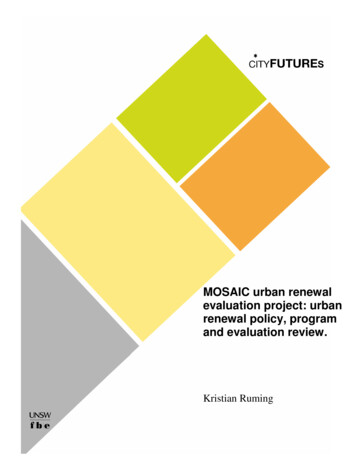
Transcription
Structural Estimation in Urban Economics*Thomas J. HolmesUniversity of Minnesota and Federal Reserve Bank of MinneapolisHolger SiegUniversity of PennsylvaniaPrepared for the Handbook of Regional and Urban EconomicsRevised Draft, September 2014Abstract: Structural estimation is a methodological approach in empirical economics explicitly based on economic theory, in which economic modeling, estimation, and empiricalanalysis are required to be internally consistent.This chapter illustrates the structuralapproach with three applications in urban economics: (1) discrete location choice, (2) fiscalcompetition and local public good provision, and (3) regional specialization. For each application, we first discuss broad methodological principles of model selection and development.Next we treat issues of identification and estimation. The final step of each discussion ishow estimated structural models can be used for policy analysis.*We would like to thank Nate Baum-Snow, Gilles Duranton, Dennis Epple, Vernon Henderson, Andy Postlewaite, and Will Strange for helpful discussions and detailed comments.The views expressed herein are those of the authors and not necessarily those of the FederalReserve Bank of Minneapolis, the Federal Reserve Board, or the Federal Reserve System.KeywordsStructural estimation; Fiscal competition; Public good provision; Regional specializationJEL classification: R10, R23, R511
1An Introduction to Structural EstimationStructural estimation is a methodological approach in empirical economics explicitly basedon economic theory. A requirement of structural estimation is that economic modeling, estimation, and empirical analysis be internally consistent. Structural estimation can also bedefined as theory-based estimation: the objective of the exercise is to estimate an explicitlyspecified economic model that is broadly consistent with observed data. Structural estimation, therefore, differs from other estimation approaches that are either based on purelystatistical models or based only implicitly on economic theory.1 A structural estimation exercise typically consists of the following three steps: (1) model selection and development, (2)identification and estimation, and (3) policy analysis. We discuss each step in detail and thenprovide some applications to illustrate the key methodological issues that are encounteredin the analysis.1.1Model Selection and DevelopmentThe first step in a structural estimation exercise is the development or selection of an economic model. These models can be simple static decision models under perfect informationor complicated nonstationary dynamic equilibrium models with asymmetric information.It is important to recognize that a model that is suitable for structural estimation needsto satisfy requirements that are not necessarily the same requirements that a theorist wouldtypically find desirable. Most theorists will be satisfied if an economic model captures the keyideas that need to be formalized. In structural estimation, we search for models that help usunderstand the real world and are consistent with observed outcomes. As a consequence, weneed models that are not rigid, but sufficiently flexible to fit the observed data. Flexibility isnot necessarily a desirable property for a theorist, especially if the objective is to analytically1For example, the most prominent approach in program evaluation is based on work by Neyman (1923)and Fisher (1935), who suggested to evaluate the impact of a program by using potential outcomes thatreflect differences in treatment status. The objective of the exercise, then, is typically to estimate averagetreatment effects. This is a purely statistical model, which is sufficiently flexible such that it has broadapplications in many sciences.2
characterize the properties of a model.Theorists are typically reluctant to work with parametrized versions of their model, sincethey aim for generality. An existence proof is, for example, considered to be of limited usefulness by most theorists if it crucially depends on functional form assumptions. Flexibleeconomic models often have the property that equilibria can only be computed numerically, i.e., there are no analytical solutions. Numerical computations of equilibria require afully parametrized and numerically specified model. The parametric approach is, therefore,natural to structural modeling in microeconomics as well as to much of modern quantitative macroeconomics. Key questions, then, are how to determine the parameter values andwhether the model is broadly consistent with observed outcomes. Structural estimation provides the most compelling approach to determine plausible parameter values for a large classof models and evaluate the fit of the model.1.2Identification and EstimationStructural estimation also requires that we incorporate a proper error structure into theeconomic model. Since theory and estimation must be internally consistent, the modelunder consideration needs to generate a well-specified statistical model.2 Any economicmodel is, by definition, an abstraction of the real world. As a consequence, it cannot be anexact representation of the “true” data-generating process. This criticism is not specific tostructural estimation, since it also applies to any purely statistical modeling and estimationapproach. We are interested in finding economic models that, in the best-case scenario,cannot be rejected by the data using conventional statistical hypothesis or specificationtests. Of course, models that are rejected by the data can also be very helpful and improveour knowledge. These models can provide us with guidance on how to improve our modelingapproach, generating a better understanding of the research questions that we investigate.A standard approach for estimating structural models requires the researcher to compute2Notice that this is another requirement that is irrelevant from a theorist’s perspective.3
the optimal decision rules or the equilibrium of a model to evaluate the relevant objectivefunction of an extremum estimator. It is a full-solution approach, since the entire model iscompletely specified on the computer. In many applications, it is not possible to use cannedstatistical routines to do this. Rather, the standard approach involves programming aneconomic model, though various procedures and routines can be pulled off the shelf to use insolving the model.3 The step of obtaining a solution of an economic model for a given set ofparameters is called the “inner loop” and often involves a fixed point calculation (i.e., takingas given a vector of endogenous variables, agents in the model make choices that result in thesame vector of endogenous variables, satisfying the equilibrium conditions). There is alsoan “outer loop” step in which the parameter vector is varied and a maximization problem issolved to obtain the parameter vector that best fits the data according to a given criterion.The outer/inner loop approach is often called a “nested fixed point” algorithm.Whenever we use nested fixed point algorithms, the existence and uniqueness of equilibrium are potentially important aspects of the analysis. Uniqueness of equilibrium is nota general property of most economic models, especially those that are sufficiently flexibleto be suited for structural estimation. Moreover, proving uniqueness of equilibrium can berather challenging.4 Nonuniqueness of equilibrium can cause a number of well-known problems during estimation and counterfactual comparative static analysis. Sometimes we maywant to condition on certain observed features of the equilibrium and only impose a subsetof the equilibrium conditions. By conditioning on observed outcomes, we often circumventa potential multiplicity of equilibria problems.Another potential drawback of the full-solution estimation approach is that it is computationally intensive. We are likely to hit the feasibility constraints quickly due to thewell-known curses of dimensionality that are encountered, for example, in dynamic pro3A useful reference for algorithms to solve economic models is Judd (1998). Another standard referencefor numerical recipes in C-programming is Press et al. (1988).4For example, the only general uniqueness proofs that we have for the Arrow-Debreu model rely onhigh-level assumptions about the properties of the excess demand function.4
gramming.5It is, therefore, often desirable to derive estimation approaches that do not rely on fullsolution approaches. Often we can identify and estimate the parameters of a model usingnecessary conditions of equilibrium, which can take the form of first-order conditions, inequality constraints, or boundary indifference conditions. We call these “partial solution”approaches.6 These approaches are often more elegant than brute force approaches, but theyare more difficult to derive, since they typically exploit specific idiosyncratic features of themodel. Finding these approaches requires a fair bit of creativity.A parametric approach is not necessary for identification or estimation. It can be useful to ask the question whether our model can be identified under weak functional formassumptions. Those approaches, then, typically lead us to consider non- or semiparametric approaches for identification or estimation. Notice that identification and estimationlargely depend on the available data, i.e., the information set of the econometrician. Thus,identification and estimation are closely linked to the data collection decisions made by theresearchers.Once we have derived and implemented an estimation procedure, we need to determinewhether our model fits the data. Goodness of fit can be evaluated based on moments used inestimation or on moments that are not used in estimation. We would also like to validate ourmodel, i.e., we would like to use some formal testing procedures to determine whether ourmodel is consistent with the data and not seriously misspecified. A number of approacheshave been proposed in the literature. First, we can use specification tests that are typicallybased on overidentifying conditions. Second, we can evaluate our model based on out-ofsample predictions. The key idea is to determine whether our model can predict the observedoutcomes in a holdout sample. Finally, we sometimes have access to experimental data that5See Rust (1998) for a discussion of computational complexity within the context of dynamic discretechoice models.6Some of the most compelling early applications of partial solution methods in structural estimation areHeckman and MaCurdy (1980) and Hansen and Singleton (1982). See Holmes (2011) for a recent exampleof an application of an inequality constraint approach used to estimate economies of density.5
may allow us to identify certain treatment or causal effects. We can then study whether ourtheoretical model generates treatment effects that are of similar magnitude.71.3Policy AnalysisThe third and final step of a structural estimation exercise consists of policy analysis. Here,the objective is to answer the policy questions that motivated the empirical analysis. Wecan conduct retrospective or prospective policy analysis.Retrospective analysis evaluates an intervention that happened in the past and is observedin the sample period. One key objective is to estimate treatment effects that are associatedwith the observed policy intervention. Not surprisingly, structural approaches compete withnonstructural approaches. As pointed out by Lucas (1976), there are some compelling reasonsfor evaluating a policy change within an internally consistent framework. The structuralapproach is particularly helpful if we are interested in nonmarginal or general equilibriumeffects of policies.Prospective analysis focuses on new policies that have not been enacted. Again, evaluating the likely impact of alternative policies within a well-defined and internally consistenttheoretical framework has some obvious advantages. Given that large-scale experimentalevaluations of alternative policies are typically expensive or not feasible in urban economics,the structural approach is the most compelling one in which to conduct prospective policyanalysis.1.4ApplicationsHaving provided an overview of the structural approach, we now turn to the issue of applyingthese methods in urban and regional economics. We focus on three examples that we use toillustrate broad methodological principles. Given our focus on methodology, we acknowledge7Different strategies for model validation are discussed in detail in Keane and Wolpin (1997) and Toddand Wolpin (2006).6
that we are not able to provide a comprehensive review of various papers in the field thattake a structural estimation approach.8Our first application is location choice. This is a classic issue, one that was addressed inearly applications of McFadden’s Nobel Prize-winning work on discrete choice [McFadden(1978)]. As noted earlier, structural estimation projects typically require researchers to writeoriginal code. The literature on discrete choice is well developed, practitioner’s guides arepublished, and reliable computer code is available on the web.Our second application considers the literature on fiscal competition and local publicgood provision. One of the key functions of cities and municipalities is to provide importantpublic goods and services such as primary and secondary education, protection from crime,and infrastructure. Households are mobile and make locational decisions based, at least inpart, on differences in public goods, services, and local amenities. This analysis combinesthe demand side of household location choice with the supply side of what governmentsoffer. Since the focus is on positive analysis, political economy models are used to model thebehavior of local governments. In this literature, one generally does not find much in theway of canned software, but we provide an overview of the basic steps for working in thisarea.The third application considers recent papers related to the allocation of economic activity across space, including the Ahlfeldt et al. (2014) analysis of the internal structure of thecity of Berlin and the Holmes and Stevens (2014) analysis of specialization by industry ofregions in the United States. We use the discussion to highlight (1) the development of themodels, (2) identification and the basic procedure for estimation, and (3) how the modelscan be used for policy analysis.8For example, we do not discuss a number of papers that are squarely in the structural tradition, suchas Holmes (2005), Gould (2007), Baum-Snow and Pavan (2012), Kennan and Walker (2011), or Combes etal. (2012).7
2Revealed Preference Models of Residential ChoiceA natural starting point for a discussion of structural estimation in urban and regional economics is the pioneering work by Daniel McFadden on estimation of discrete choice models.One of the main applications that motivated the development of these methods was residential or locational choice. In this section, we briefly review the now classic results fromMcFadden and discuss why urban economists are still struggling with some of the sameproblems that McFadden studied in the early 1970s.The decision theoretic framework that underlies modern discrete choice models is fairlystraightforward. We consider a household i that needs to choose among different neighborhoods that are indexed by j. Within each neighborhood there are a finite number of differenthousing types indexed by k. A basic random utility model assumes that the indirect utilityof household i for community j and house k is given byuijk x0j β zk0 γ α(yi pjk ) ijk ,(1)where xj is a vector of observed characteristics of community j, zk is a vector of observedhousing characteristics, yi is household income, and pjk is the price of housing type k incommunity j. Each household chooses the neighborhood-housing pair that maximizes utility. One key implication of the behavioral model is that households make deterministicchoices, i.e., for each household there exists a unique neighborhood-house combination thatmaximizes utility.McFadden (1974a,b) showed how to generate a well-defined econometric model that isinternally consistent with the economy theory described above. Two assumptions are particularly noteworthy. First, we need to assume that there is a difference in information setsbetween households and econometricians. Although households observe all key variablesincluding the error terms ( ijk ), econometricians only observe xj , zk , yi , pjk , and a set ofindicators, denoted by dijk , where dijk 1 if household i chooses neighborhood j and house8
type k and zero otherwise. Integrating out the unobserved error terms then gives rise towell-behaved conditional choice probabilities that provide the key ingredient for a maximumlikelihood estimator of the parameters of the model.Second, if the error terms are independent and identically distributed (i.i.d.) across i, j,and k and follow a type I extreme value distribution, we obtain the well-known conditionallogit choice probabilities:exp{x0j β zk0 γ α(yi pjk )}.PK0 β z 0 γ α(y pexp{x)}inmnmn 1m 1P r{dijk 1 x, z, p, yi } PJ(2)A key advantage of the simple logit model is that conditional choice probabilities have aclosed-form solution. The only problem encountered in estimation is that the likelihoodfunction is nonlinear in its parameters. The estimates must be computed numerically. Allstandard software packages will, by now, allow researchers to do that. Standard errors canbe computed using the standard formula for maximum likelihood estimators.One unattractive property of the logit model is the independence of irrelevant alternatives (IIA) property. It basically says that the ratio of conditional choice probabilities oftwo products depends only on the relative utility of those two products. Another (related)unattractive property of the simple logit model is that it generates fairly implausible substitution patterns for the aggregate demand. Own and cross-price elasticities are primarilyfunctions of a single parameter (α) and are largely driven by the market shares and not bythe proximity of two products in the characteristic space.One way to solve this problem is to relax the assumption that idiosyncratic tastes areindependent across locations and houses. McFadden (1978) suggested modeling the distribution of the error terms as a generalized extreme value distribution, which then gives rise tothe nested logit model. In our application, we may want to assume that idiosyncratic shocksof houses within a given neighborhood are correlated due to some unobserved joint neighborhood characteristics. A main advantage of the nested logit model is that conditional choice9
probabilities still have closed-form solutions, and estimation can proceed within a standardparametric maximum likelihood framework. Again, most major software packages will havea routine for nested logit models. Hence, few technical problems are involved in implementing this estimator and computing standard errors. The main drawback of the nested logit isthat the researcher has to choose the nesting structure before estimation. As a consequence,we need to have strong beliefs about which pairs of neighborhood-house choices are mostlikely to be close substitutes. We, therefore, need to have detailed knowledge about theneighborhood structure within the city that we study in a given application.An alternative approach, one that avoids the need to impose a substitution structureprior to estimation and can still generate realistic substitution patterns, is based on randomcoefficients.9 Assume now that the utility function is given byijk x0j βi zk0 γi αi (yi pjk ) ijk ,(3)where γi , βi , and αi are random coefficients. A popular approach is based on the assumptionthat these random coefficients are normally distributed. It is fairly straightforward to showthat substitutability in the random coefficient logit model is driven by observed housing andneighborhood characteristics. Households that share similar values of random coefficients willsubstitute between neighborhood-housing pairs that have similar observed characteristics.A key drawback of the random coefficient model is that the conditional choice probabilities no longer have closed-form solutions and must be computed numerically. Thisprocess can be particularly difficult if there are many observed characteristics, and hencehigh-dimensional integrals need to be evaluated. These challenges partially led to the development of simulation-based estimators [see Newey and McFadden (1994) for some basicresults on consistency and asymptotic normality of simulated maximum likelihood estimators]. As discussed, for example, in Judd (1998), a variety of numerical algorithms have beendeveloped that allow researchers to solve these integration problems. A notable application9For a detailed discussion, see, for example, Train (2003).10
of these methods is Hastings, Kane, and Staiger (2006), who study sorting of householdsamong schools within the Mecklenburg Charlotte school district. They evaluate the impactof open enrollment policies under a particular parent choice mechanism.10Demand estimation has also focused on the role of unobserved product characteristics[Berry (1994)]. In the context of our application, unobserved characteristics may arise at theneighborhood level or the housing level. Consider the case of an unobserved neighborhoodcharacteristic. The econometrician probably does not know which neighborhoods are popular. More substantially, our measures of neighborhood or housing quality (or both) may berather poor or incomplete. Let ξj denote an unobserved characteristic that captures aspectsof neighborhood quality that are not well measured by the researcher. Utility can now berepresented by the following equation:uijk x0j βi zk0 γi αi (yi pjk ) ξj ijk .(4)This locational choice model is then almost identical in mathematical structure to the demand model estimated in Berry, Levinsohn, and Pakes (1995; hereafter, BLP). The keyinsight of that paper is that the unobserved product characteristics can be recovered bymatching the observed market shares of each product. The remaining parameters of themodel can be estimated by using a generalized method of moments (GMM) estimator thatuses instrumental variables to deal with the correlation between housing prices and unobserved neighborhood characteristics. Notice that the BLP estimator is a nested fixedpoint estimator. The inner loop inverts the market share equations to compute the unobserved product characteristics. The outer loop evaluates the relevant moment conditions andsearchers over the parameter space.Estimating this class of models initially required some serious investment in programming,since standard software packages did not contain modules for this class of models. By10Bayesian estimators can also be particularly well suited for estimating discrete choice models with randomcoefficients. Bajari and Kahn (2005) adopt these methods to study racial sorting and peer effects within asimilar framework.11
now, however, both a useful practitioner’s guide [Nevo (2000)] and a variety of programsare available and openly shared. This change illustrates an important aspect of structuralestimation. Although structural estimation may require some serious initial methodologicalinnovations, subsequent users of these techniques often find it much easier to modify andimplement these techniques.11 Notable papers that introduced this empirical approach tourban economics are Bayer (2001), Bayer, McMillan, Reuben (2004), and Bayer, Ferreira,McMillan (2007), who estimate models of household sorting in the Bay Area.Extending these models to deal with the endogenous neighborhood characteristics or peereffects is not trivial. For example, part of the attractiveness of a neighborhood may be drivenby the characteristics of neighbors. Households may value living, for example, in neighborhoods with a large fraction of higher-income households because of the positive externalitiesthat these families may provide. Three additional challenges arise in these models. First, peereffects need to be consistent with the conditional choice probabilities and the implied equilibrium sorting. Second, endogenous peer effects may give rise to multiplicity of equilibria,which creates additional problems in computation and estimation. Finally, the standard BLPinstrumenting strategy, which uses exogenous characteristics of similar house-neighborhoodpairs, is not necessarily feasible anymore, since we deal with endogenous neighborhood characteristics that are likely to be correlated with the unobserved characteristics.12 Findingcompelling instruments can be rather challenging. Some promising examples are Ferreira(2009), who exploits the impact of property tax limitations (Proposition 13) in California onhousehold sorting. Galiani, Murphy, Pantano (2012) exploit random assignment to vouchersto construct instruments in their study of the effectiveness of the Moving to Opportunityhousing assistance experiment.Researchers have also started to incorporate dynamic aspects into the model specification.11Computation of standard errors is also nontrivial, as discussed in Berry, Linton, Pakes (2004). Mostapplied researchers prefer to bootstrap standard errors in these models.12Bayer and Timmins (2005) and Bayer, Ferreira, and McMillan (2007) provide a detailed discussion ofthese issues in the context of the random utility model above. See also the survey articles on peer effects andsorting in this handbook. Epple, Jha, and Sieg (2014) estimate a game of managing school district capacity,in which school quality is largely defined by peer effects.12
Locational choices and housing investments are inherently dynamic decisions that affectmultiple time periods. As a consequence, adopting a dynamic framework involves someinherent gains. In principle, we can follow Rust (1987), but adopting a dynamic versionof the logit model within the context of locational choice is rather challenging. Considerthe recent paper by Murphy (2013), who estimates a dynamic discrete choice model of landconversion using data from the Bay Area. One key problem is measuring prices for land(and housing). In a dynamic model, households must also forecast the evolution of futureland and housing prices to determine whether developing a piece of land is optimal. Thatcreates two additional problems. First, we need to characterize price expectations based onsimple time series models. Second, we need one pricing equation for each location [assumingland or housing (or both) within a neighborhood is homogeneous], which potentially blowsup the dimensionality of state space associated with the dynamic programming problem.13Some user guides are available for estimating dynamic discrete choice models, most notablythe chapter by Rust (1994) in the Handbook of Econometrics, volume 4. Estimation andinference is fairly straightforward as long as one stays within the parametric maximumlikelihood framework. Thanks to the requirement to disclose estimation codes by a varietyof journals, some software programs are also available that can be used to understand thebasic structure of the estimation algorithms. However, each estimation exercise requiressome coding.Finally, researchers have worked on estimating discrete choice models when there is rationing in housing markets. Geyer and Sieg (2013) develop and estimate a discrete choicemodel that captures excess demand in the market for public housing. The key issue is thatsimple discrete choice models give rise to biased estimators if households are subject to rationing and, thus, do not have full access to all elements in the choice set. The idea ofthat paper is to use a fully specified equilibrium model of supply and demand to capture13Other promising examples of dynamic empirical approaches are Bishop (2011), who adopts a Hotz-Millerconditional choice probabilities estimator, and Bayer et al. (2012). Yoon (2012) studies locational sorting inregional labor markets, adopting a dynamic nonstationary model.13
the rationing mechanism and characterize the endogenous (potentially latent) choice set ofhouseholds. Again, we have to use a nested fixed point algorithm to estimate these types ofmodels. The key finding of this paper is that accounting for rationing implies much higherwelfare benefits associated with public housing communities than simple discrete choice estimators that ignore rationing.3Fiscal Competition and Public Good ProvisionWe next turn to the literature on fiscal competition and local public good provision. As notedabove, one key functions of cities and municipalities is to provide important public goods andservices. Households are mobile and make locational decisions based on differences in publicgoods, services, and local amenities. The models developed in the literature combine thedemand side of household location choice, that are similar to the ones studied int he previoussection, with political economy models are used to model the behavior of local governmentsWe start Section 3.1 by outlining a generic model of fiscal competition that provides thebasic framework for much of the empirical work in the literature. We develop the key parts ofthe model and define equilibrium. We also discuss existence and uniqueness of equilibriumand discuss key properties of these models. We finish by discussing how to numericallycompute equilibria for more complicated specifications of the model, and we discuss usefulextensions.In Section 3.2, we turn to an empirical issue. We start by broadly characterizing the keypredictions of this class of models and then develop a multistep approach that can be usedto identify and estimate the parameters of the
to satisfy requirements that are not necessarily the same requirements that a theorist would typically nd desirable. Most theorists will be satis ed if an economic model captures the key ideas that need to be formalized. In structural estimation, we search for models that help us understand the real world and are consistent with observed outcomes. As a consequence, we need models that are not .










